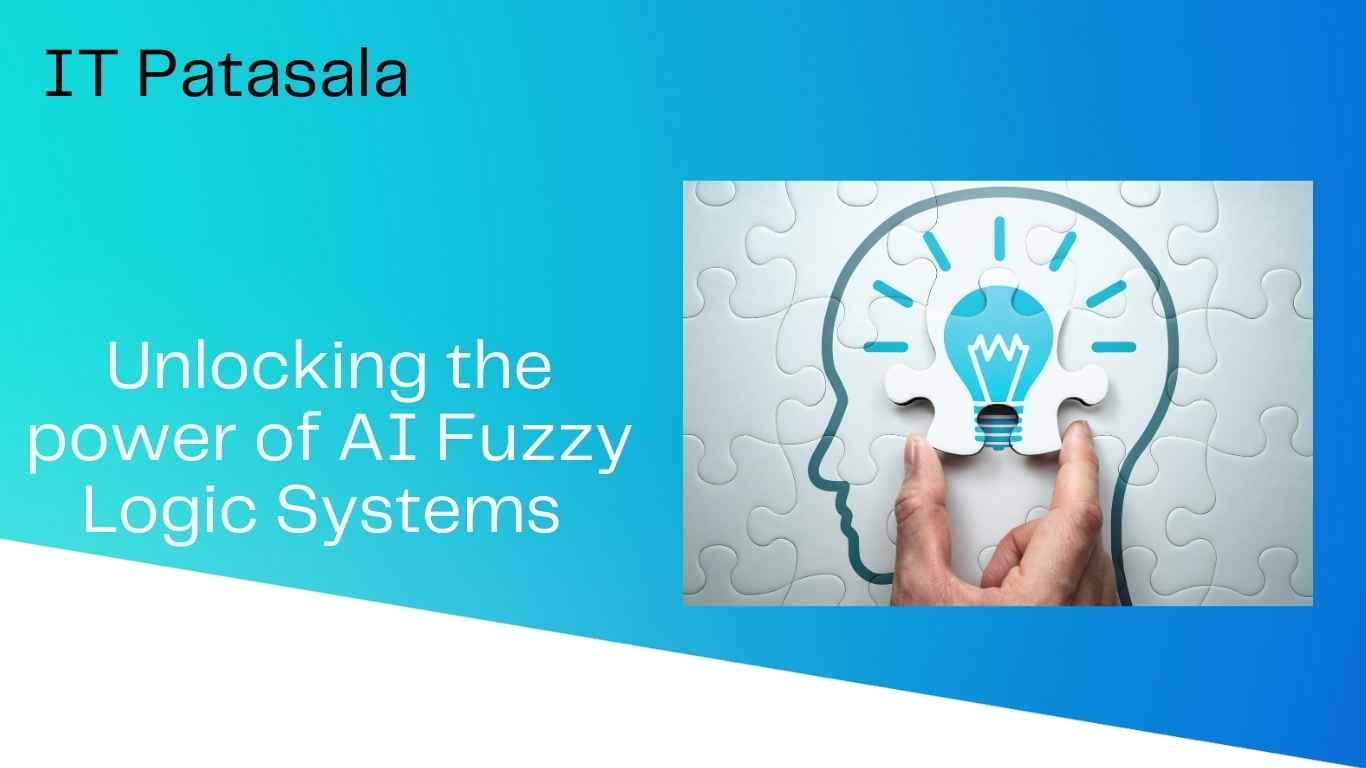Unlocking the power of AI Fuzzy Logic Systems | Best 2+ Examples
🧠 AI Fuzzy Logic Systems: Principles, Applications & Examples
Artificial Intelligence (AI) has revolutionized industries with machine learning, computer vision, and neural networks. However, one often overlooked pillar of AI that plays a crucial role in decision-making under uncertainty is Fuzzy Logic.
In this article, we’ll explore:
- What Fuzzy Logic is in AI
- Its origins and theory
- How Fuzzy Logic Systems (FLS) are built
- Real-world applications
- Examples and use cases
- Tools and programming for implementation
- Benefits and limitations
Let’s demystify this powerful technique that mimics human reasoning better than traditional binary logic ever could.
📘 What Is Fuzzy Logic in AI?
Fuzzy Logic is a form of logic that deals with degrees of truth rather than strict binary (true or false) logic.
Instead of stating something is entirely true (1) or false (0), fuzzy logic allows for values between 0 and 1, making it more human-like in reasoning.
For example:
- Traditional logic: “The room is hot” → True/False
- Fuzzy logic: “The room is 70% hot” → Partial truth
This flexibility makes it perfect for handling uncertainty, ambiguity, and imprecision in real-world systems.
🧪 Origins and Foundation of Fuzzy Logic
Fuzzy logic was first introduced by Lotfi Zadeh in 1965, a professor at the University of California, Berkeley.
His goal was to create a system that could process vague data and make human-like decisions, just like how we think in “degrees” instead of absolutes.
🧠 How Fuzzy Logic Systems Work
An AI Fuzzy Logic System (FLS) typically has the following architecture:
- Fuzzification Module – Converts crisp numerical input into fuzzy values using membership functions
- Knowledge Base – Contains fuzzy rules (If-Then statements)
- Inference Engine – Applies fuzzy logic rules to the fuzzified inputs
- Defuzzification Module – Converts fuzzy output back into a crisp value
Let’s explore each part.
🔍 1. Fuzzification: Making Data “Fuzzy”
Fuzzification maps input values to membership functions. These functions determine how much a value belongs to a linguistic category like “Low,” “Medium,” or “High.”
Example:
- Temperature = 70°F
- Membership:
- Low: 0.2
- Medium: 0.7
- High: 0.1
Thus, the temperature is mostly Medium.
📘 2. Rule Base: Human-Like Reasoning
Fuzzy rules are written in natural language:
IF temperature IS high AND humidity IS low THEN fan_speed IS high
These rules mimic human decision-making.
🧮 3. Inference Engine: Apply the Rules
It processes the inputs based on the rule base using fuzzy logic operators:
- AND → Minimum
- OR → Maximum
- NOT → Complement
It combines multiple rules to produce fuzzy output values.
🔄 4. Defuzzification: Convert to Final Output
The fuzzy results are then converted to a single crisp value using methods like:
- Centroid Method (most common)
- Bisector Method
- Mean of Maximum
This crisp value can be used to control real-world systems.
💡 Real-Time Example: Air Conditioner Control
Problem: Automate AC fan speed based on temperature and humidity.
- Inputs: Temperature, Humidity
- Output: Fan Speed
- Rules:
- IF Temp IS High AND Humidity IS High → Fan Speed is Very High
- IF Temp IS Medium AND Humidity IS Low → Fan Speed is Medium
Result: Smooth, human-like control rather than abrupt on/off actions.
🏗️ Tools to Build Fuzzy Logic Systems
- MATLAB Fuzzy Logic Toolbox – Graphical UI for designing fuzzy controllers
- Python Libraries –
scikit-fuzzy,fuzzywuzzy,simpful - LabVIEW – Visual programming used in engineering
- FuzzyLite – C++ and Java fuzzy logic libraries
💻 Python Example Using scikit-fuzzy
import numpy as np
import skfuzzy as fuzz
from skfuzzy import control as ctrl
# Define inputs and output
temperature = ctrl.Antecedent(np.arange(0, 101, 1), 'temperature')
humidity = ctrl.Antecedent(np.arange(0, 101, 1), 'humidity')
fan_speed = ctrl.Consequent(np.arange(0, 101, 1), 'fan_speed')
# Membership functions
temperature['low'] = fuzz.trimf(temperature.universe, [0, 0, 50])
temperature['medium'] = fuzz.trimf(temperature.universe, [30, 50, 70])
temperature['high'] = fuzz.trimf(temperature.universe, [50, 100, 100])
humidity['low'] = fuzz.trimf(humidity.universe, [0, 0, 50])
humidity['high'] = fuzz.trimf(humidity.universe, [50, 100, 100])
fan_speed['low'] = fuzz.trimf(fan_speed.universe, [0, 0, 50])
fan_speed['high'] = fuzz.trimf(fan_speed.universe, [50, 100, 100])
# Define rules
rule1 = ctrl.Rule(temperature['high'] & humidity['high'], fan_speed['high'])
rule2 = ctrl.Rule(temperature['low'] | humidity['low'], fan_speed['low'])
# Create control system
fan_ctrl = ctrl.ControlSystem([rule1, rule2])
fan = ctrl.ControlSystemSimulation(fan_ctrl)
# Pass inputs
fan.input['temperature'] = 75
fan.input['humidity'] = 60
# Compute result
fan.compute()
print(f"Fan speed: {fan.output['fan_speed']}")
🌐 Real-World Applications of AI Fuzzy Logic Systems
🚗 1. Automotive
- Automatic Gearboxes
- Anti-lock Braking Systems (ABS)
- Self-parking systems
- Speed and steering control
🏭 2. Industrial Control Systems
- Boiler control
- Robotic arm precision
- Manufacturing automation
Example: Washing machines adjust wash time and speed based on dirt level using fuzzy logic.
🏠 3. Smart Home Automation
- Intelligent thermostats
- Adaptive lighting systems
- Smart refrigerators adjusting cooling
🧠 4. Medical Diagnosis Systems
- Predict disease severity
- Assess treatment effectiveness
- Aid in uncertain or borderline cases
Example: Estimating diabetic risk using fuzzy inference from glucose, weight, and age.
📷 5. Image Processing
- Fuzzy edge detection
- Color correction
- Noise filtering
Fuzzy logic improves visual clarity where traditional algorithms fail.
📊 6. Decision Support Systems
- Financial forecasting
- Risk assessment in insurance
- Customer satisfaction analysis
🎯 Advantages of Fuzzy Logic Systems
- Mimics human reasoning
- Handles vague/uncertain data
- No need for precise inputs
- Highly customizable
- Widely applicable across domains
⚠️ Limitations of Fuzzy Logic Systems
- Rule design can be complex
- Not suitable for high-dimensional data
- May lack self-learning (unless combined with ML)
- Performance depends on well-tuned membership functions
🔄 Fuzzy Logic vs Traditional Logic
| Aspect | Traditional Logic | Fuzzy Logic |
|---|---|---|
| Precision | Requires exact input | Handles uncertainty |
| Decision-making | Binary (yes/no) | Partial (0-1 scale) |
| Use Case | Engineering, math | Real-world, adaptive |
| Flexibility | Low | High |
🔗 Fuzzy Logic + AI: A Powerful Hybrid
Today, fuzzy logic is often integrated with machine learning, neural networks, and evolutionary algorithms to build adaptive, intelligent systems.
Example: Neuro-Fuzzy Systems
These systems learn fuzzy rules automatically from data, combining the interpretability of fuzzy logic with the learning power of neural networks.
✅ Final Thoughts: Why Learn About AI Fuzzy Logic Systems?
If you’re stepping into the world of AI and intelligent systems, fuzzy logic is essential for understanding how machines deal with imprecision, uncertainty, and soft boundaries—just like humans do.
Whether you’re building a smart washing machine, a medical support system, or a game AI, Fuzzy Logic Systems empower machines to think like us—in degrees, not absolutes.
Mastering fuzzy logic will not only enhance your understanding of AI but also make your solutions more human-friendly, flexible, and intelligent.
Also read these




